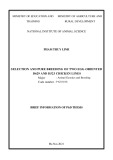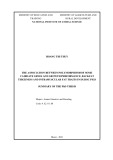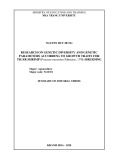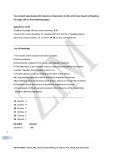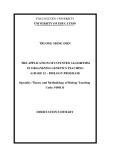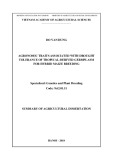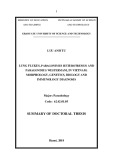Fatty acid composition of chylomicron remnant-like particles influences their uptake and induction of lipid accumulation in macrophages Clara De Pascale1, Michael Avella1, Javier S. Perona2, Valentina Ruiz-Gutierrez2, Caroline P. D. Wheeler-Jones1 and Kathleen M. Botham1
1 Department of Veterinary Basic Sciences, Royal Veterinary College, London, UK 2 Instituto de la Grasa (CSIC), Seville, Spain
Keywords chylomicron remnant-like particles; fatty acid composition; lipid accumulation; macrophages
Correspondence K. M. Botham, Department of Veterinary Basic Sciences, Royal Veterinary College, Royal College St, London NW1 0TU, UK Fax: +44 207468 5204 Tel: +44 207468 5274 E-mail: kbotham@rvc.ac.uk
(Received 30 August 2006, revised 10 Octo- ber 2006, accepted 23 October 2006)
doi:10.1111/j.1742-4658.2006.05552.x
The influence of the fatty acid composition of chylomicron remnant-like particles (CRLPs) on their uptake and induction of lipid accumulation in macrophages was studied. CRLPs containing triacylglycerol enriched in saturated, monounsaturated, n)6 or n)3 polyunsaturated fatty acids derived from palm, olive, corn or fish oil, respectively, and macrophages derived from the human monocyte cell line THP-1 were used. Lipid accu- mulation (triacylglycerol and cholesterol) in the cells was measured after incubation with CRLPs for 5, 24 and 48 h, and uptake over 24 h was determined using CRLPs radiolabelled with [3H]triolein. Total lipid accu- mulation in the macrophages was significantly greater with palm CRLPs than with the other three types of particle. This was mainly due to increased triacylglycerol concentrations, whereas changes in cholesterol concentrations did not reach significance. There were no significant differ- ences in lipid accumulation after incubation with olive, corn or fish CRLPs. Palm and olive CRLPs were taken up by the cells at a similar rate, which was considerably faster than that observed with corn and fish CRLPs. These findings demonstrate that CRLPs enriched in saturated or monoun- saturated fatty acids are taken up more rapidly by macrophages than those enriched in n)6 or n)3 polunsaturated fatty acids, and that the faster uptake rate results in greater lipid accumulation in the case of saturated fatty acid-rich particles, but not monounsaturated fatty acid-rich particles. Thus, dietary saturated fatty acids carried in chylomicron remnants may enhance their propensity to induce macrophage foam cell formation.
The first visible lesions in atherosclerosis development are fatty streaks, which are formed when macrophages that have invaded the artery wall take up lipid from plasma lipoproteins in the subendothelial space and become so engorged that they form foam cells [1]. It is known that low-density lipoprotein (LDL) has a major role in the induction of foam cell formation, but it is also clear that oxidation of the LDL particles, a pro-
cess that can occur within the artery wall, is necessary before extensive lipid accumulation occurs [2]. Recent work in our laboratory and others, however, has pro- vided strong evidence that chylomicron remnants, the lipoproteins that carry fat and cholesterol from the diet, are also able to induce macrophages to form foam cells, and furthermore, that prior oxidation of the particles is not required for their effect [3–5].
Abbreviations CRLP, chylomicron remnant-like particle; LDL, low-density lipoprotein; LRP, LDL receptor-like protein; MUFA, monounsaturated fatty acid; PMA, phorbol 12-myristate 13-acetate; PUFA, polyunsaturated fatty acid; SFA, saturated fatty acid; TC, total cholesterol; TG, triacylglycerol.
FEBS Journal 273 (2006) 5632–5640 ª 2006 The Authors Journal compilation ª 2006 FEBS
5632
C. De Pascale et al.
Lipid accumulation in macrophages
mechanism by which dietary fats could directly influ- ence atherosclerotic lesion development during their transport from the gut to the liver. Little is known, however, about how the fatty acid composition of chylomicron remnants affects their uptake by macro- phages and induction of excessive lipid accumulation in the cells.
Fat and cholesterol consumed in the diet are taken up by intestinal cells and secreted into lymph in chylo- microns. These large triacylglycerol (TG)-rich lipopro- teins then enter the blood via the thoracic duct and are metabolized by lipoprotein lipase, a process that removes some of the triacylglycerol and leaves smaller chylomicron remnant particles, which deliver the remaining lipid to the liver [6]. A number of lines of evidence provide a powerful case to support the ath- erogenicity of chylomicron remnants [7,8]. It has been demonstrated that the particles enter the artery wall as efficiently as LDL [9,10], and are retained within the subendothelial space [7,11]; accumulation of remnants in the plasma of apoE– ⁄ – mice is associated with the development of severe atherosclerosis [12]; remnant- like lipoproteins have been isolated from human aortic intima and atherosclerotic plaque [13,14]; and delay in remnant clearance from the circulation has been found to be correlated with the development of atheroscler- otic lesions in human patients [15,16].
In this study, we have investigated the effects of chylomicron remnants of different fatty acid composi- tion on macrophage foam cell formation using CRLPs [4,5,19,20] and macrophages derived from the human monocyte cell line THP-1. CRLPs enriched in SFAs, MUFAs, n)6 PUFAs and n)3 PUFAs, obtained by incorporating TG from palm, olive, corn and fish oil, respectively, into the particles were incubated with THP-1 macrophages, and the concentrations of choles- terol and TG accumulated were determined. In addi- tion, the effects of varying fatty acid composition on the uptake of the CRLPs by the cells was studied using the four types of particle radiolabelled with [3H]triolein.
Results
Characteristics of CRLPs
[18],
primary
(olive CRLPs),
In previous studies, chylomicron remnants or chylo- (CRLPs) have been micron remnant-like particles shown to induce extensive lipid accumulation in a variety of macrophage types, including the murine macrophage cell line J774 [17], mouse peritoneal macro- human monocyte-derived phages macrophages [3,4] and macrophages derived from the human monocyte cell line THP-1 [4,5,19,20]. Both cho- lesterol and TG accumulate in response to remnant particles, and the concentrations of TG found are much greater than those observed on exposure of the macrophages to an equivalent amount of cholesterol in oxidized LDL (oxLDL) [4,20]. Moreover, once inside the cells, the lipid taken up appears to be resistant to efflux [20], as is the case with lipid originating from oxLDL [21].
of
consumption
The content of TG and total cholesterol (TC) and the TG ⁄ TC ratio in CRLPs containing TG from palm (palm CRLPs), olive corn (corn CRLPs) or fish (fish CRLPs) oil are shown in Table 1. Although the TG and TC concentrations varied some- what in the different types of CRLP, with those in palm CRLPs tending to be lower, these values are dependent on the dilution of the preparations. More importantly, there were no significant differences in the TG ⁄ TC ratio between palm, olive, corn and fish CRLPs. Thus, although the CRLPs were added to the incubations according to the TG concentration, cell the amount of cholesterol present was also similar in experiments with the different types of particle. The
Table 1. Lipid content of CRLPs derived from different oils. CRLPs containing TG from palm, olive, corn or fish oils were prepared as described in Experimental procedures, and TG and TC contents were measured. Data shown are the mean ± SEM from seven separate preparations.
CRLP type
TG (lmolÆmL)1)
TC (lmolÆmL)1)
TG ⁄ TC
the particles with macrophages
Palm Olive Corn Fish
9.0 ± 1.4 13.0 ± 1.2 11.7 ± 1.7 15.8 ± 3.3
0.7 ± 0.2 1.6 ± 0.6 1.2 ± 0.2 1.5 ± 0.3
10.6 ± 1.1 12.1 ± 2.6 10.5 ± 1.8 8.8 ± 1.3
It has been known for many years that the type of fat in the diet influences the development of athero- sclerosis, with polyunsaturated (PUFA) or monounsaturated (MUFA), as compared with saturated (SFA), fatty acids decreasing the risk [22]. Our earlier work has shown that the fatty acid composition of chylomicron remnants reflects that of the diet [23], and modulates their removal from the blood by the liver, with particles derived from fish (rich in n)3 PUFAs) or corn (rich in n)6 PUFAs) oil being taken up more rapidly than those from olive (rich in MUFAs) or palm (rich in SFAs) oil [24–26]. The finding that variations in the fatty acid composi- tion of remnants modify their uptake by liver cells rai- ses the possibility that such changes also affect the interaction of to promote or retard foam cell formation, providing a
FEBS Journal 273 (2006) 5632–5640 ª 2006 The Authors Journal compilation ª 2006 FEBS
5633
C. De Pascale et al.
Lipid accumulation in macrophages
Table 2. Fatty acid composition of TG in CRLPs. CRLPs were prepared using TG from palm, olive, corn or fish oil as described in Experimen- tal procedures, and the fatty acid composition was determined by gas chromatography. Data are expressed as gÆ(100 g total fatty acids))1 and are the mean ± SEM from three separate preparations. ND, none detected.
CRLPs
Palm
Olive
Corn
Fish
Fatty acid
0.47 ± 0.09 12.40 ± 0.17 1.21 ± 0.05 2.94 ± 0.02 72.74 ± 0.27 ND
4.54 ± 3.04 38.67 ± 1.58 0.63 ± 0.18 8.28 ± 4.00 36.48 ± 2.93 ND 10.58 ± 0.65 0.82 ± 0.23
9.41 ± 0.48 0.82 ± 0.00
3.06 ± 1.24 11.52 ± 0.04 0.14 ± 0.02 2.03 ± 0.13 30.00 ± 0.62 0.43 ± 0.43 51.87 ± 1.81 0.93 ± 0.03
14:0 16:0 16:1 n)7 18:0 18:1 n)9 18:1 n)7 18:2 n)6 18:3 n)3 20:4 n)6 20:4 n)3 20:5 n)3 22:5 n)3 22:6 n)3 Total SFA Total MUFA Total n)6 PUFA Total n)3 PUFA
ND ND ND ND ND 51.49 ± 2.36 37.12 ± 2.75 10.58 ± 0.64 0.82 ± 0.23
ND ND ND ND ND 15.82 ± 0.18 73.95 ± 0.31 9.41 ± 0.48 0.82 ± 0.01
ND ND ND ND ND 16.62 ± 1.33 30.58 ± 1.00 51.87 ± 1.82 0.93 ± 0.03
8.29 ± 0.32 23.59 ± 0.89 12.79 ± 0.14 3.37 ± 0.92 20.05 ± 4.07 2.91 ± 1.47 5.38 ± 1.02 2.87 ± 0.14 0.97 ± 0.07 1.69 ± 0.07 10.26 ± 0.44 1.84 ± 0.10 5.98 ± 2.99 35.25 ± 0.47 35.75 ± 2.80 6.35 ± 1.05 22.65 ± 2.25
Table 3. Concentrations of malondialdehyde (MDA) and 4-hydroxy- 2(E)-nonenal (4-HNE) in CRLPs. MDA and 4-HNE concentrations in CRLPs containing TG from palm, olive, corn or fish oil (10 lM) were determined before (0 h) and after (6 h) incubation with CuSO4 (10 lM) for 6 h. Data shown are the mean ± SEM from three separate preparations. *P < 0.05, **P < 0.01 versus olive CRLPs (one-way analysis of variance, with Tukey-Kramer’s test multiple comparison test post hoc).
4-HNE + MDA [pmolÆ(nmol TG))1]
0 h
6 h
CRLP type
signficantly different
Palm Olive Corn Fish
4.4 ± 1.2 5.8 ± 2.0 2.6 ± 1.1 11.9 ± 7.2
46.1 ± 8.0* 7.4 ± 0.7 48.5 ± 10.0* 88.9 ± 10.7**
fatty acid composition of the TG in the different types of CRLP (Table 2) reflected that of the oils from which they were obtained [23]. Thus CRLPs prepared with TG from palm oil or olive oil contained relatively high concentrations of SFAs [particularly palmitic acid (16:0)] or MUFAs [particularly oleic acid (18:1, n)9)], respectively, whereas those containing TG from corn or fish oil were relatively enriched in n)6 [mainly lino- leic acid (18:2, n)6)] or n)3 PUFAs [eicosapentaenoic acid (20:5) and docosahexanoic acid (22:6)]. The amounts of apoE in palm, olive, corn or fish CRLPs were not (one way analysis of variance) as assessed by SDS ⁄ PAGE [optical density unitsÆ(lmol TG))1 (n ¼ 3): palm CRLPs, 102 ± 25; olive CRLPs, 122 ± 46; corn CRLPs, 135 ± 19; fish CRLPs, 99 ± 36]. Assessment of
the
in
significant differences between palm, corn and fish CRLPs.
Effects of the fatty acid composition of CRLPs on their induction of lipid accumulation in THP-1 macrophages
lipid peroxidation products, 4-hydroxy-2(E)-nonenal + malondialdehyde, the CRLPs (Table 3) showed that there were no significant differences between the four different types of particle (one way analysis of variance, with Tukey-Kramer’s test post hoc), although the concentrations tended to be more variable in the fish CRLPs, as might be expec- ted from their relatively high content of long-chain n)3 PUFAs such as eicosapentaenoic acid and docosa- hexanoic acid. Lipid peroxidation products after incu- bation of the four types of CRLP with CuSO4 (10 lm) for 6 h were significantly lower with olive CRLPs than with the other three types, indicating that these parti- cles are more resistant to oxidation, but there were no
THP-1 macrophages were incubated with palm, olive, corn or fish CRLPs (0.3 lmol TGÆmL)1) for 5, 24 or 48 h, and the effects on lipid accumulation in the cells lipid (TG + TC) concentra- were determined. Total tions were similar in incubations with all four types of particle after 5 h, but analysis by two-way analysis of
FEBS Journal 273 (2006) 5632–5640 ª 2006 The Authors Journal compilation ª 2006 FEBS
5634
C. De Pascale et al.
Lipid accumulation in macrophages
Fig. 1. THP-1 macrophages were incubated with CRLPs containing TG from palm, olive, corn or fish oil, and the total lipid (TG + TC) accumulated in the cells was measured after 5, 24 and 48 h. Data are the mean from three separate experiments, and error bars show the SEM. *P < 0.05, **P < 0.01 versus palm CRLPs.
variance showed that there was significantly more accumulation in cells exposed to palm CRLPs than in those exposed to olive, corn or fish CRLPs, with signi- ficant differences after 24 and 48 h (Fig. 1). Similar analysis of the TG and TC content of the cells showed that TG followed a similar pattern to that found for total lipid (Fig. 2A), with palm CRLPs causing greater accumulation than corn (significant at 24 and 48 h) or olive or fish (significant at 48 h) CRLPs. However, although there were similar trends in TC concentra- tions, because of the lower cellular concentrations, these changes did not reach significance.
Fig. 2. THP-1 macrophages were incubated with CRLPs contain- ing TG from palm, olive, corn or fish oil, and the TG (A) and TC (B) accumulated in the cells was measured after 5, 24 and 48 h. Data are the mean from three separate experiments, and error bars show the SEM. *P < 0.05, **P < 0.01 versus palm CRLPs.
Effects of the fatty acid composition of CRLPs on their uptake by THP-1 macrophages
Fig. 3. THP-1 macrophages were incubated with CRLPs contain- ing TG from palm, olive, corn or fish oil radiolabelled with [3H]triolein, and the amount of radioactivity associated with the the time periods up to 24 h was measured. Each cells after point is the mean from three separate experiments, and error bars show the SEM.
The uptake of CRLPs by THP-1 macrophages was assessed using particles labelled in TG with [3H]triolein. There were no significant differences (one-way analysis of variance) between the specific activities of the four different types of CRLP used [dpmÆ(nmol TG))1 (n ¼ 4): palm, 2601 ± 326; olive, 2041 ± 154; corn, 2290 ± 303; fish, 1764 ± 140). Cells were incubated with radiolabelled palm, olive, corn or fish CRLPs for periods up to 24 h, and the radioactivity associated with the cells was measured (Fig. 3). Palm and olive CRLPs were taken up by the cells significantly more rapidly than corn and fish CRLPs (P < 0.01) with sig- nificant differences at 13 h (P < 0.01) and 24 h (P < 0.01). Corn and fish CRLPs were taken up at very similar rates, and there were also no significant differences in the rates of uptake of palm and olive CRLPs.
FEBS Journal 273 (2006) 5632–5640 ª 2006 The Authors Journal compilation ª 2006 FEBS
5635
C. De Pascale et al.
Lipid accumulation in macrophages
Discussion
particles were enriched in the particular type of fatty acid predominating in the oil, but also contained a complex mixture of other fatty acids, as occurs in vivo. As might be expected, the fatty acid composition of CRLPs containing TG from palm, olive, corn or fish oil (Table 2) was similar to both that of the parent oils and that of rat physiological remnants derived from them [23], so that the CRLPs were enriched in SFAs, MUFAs, n)6 PUFAs and n)3 PUFAs, respectively.
remnants,
ratio
the TG ⁄ TC molar
did
not
reach
significance.
(Fig. 3),
lowering
lipid
thus
the
In previous work, we have used human monocyte- derived macrophages and macrophages derived from the human monocyte cell line THP-1 to investigate the uptake of chylomicron remnants and their induction of lipid accumulation in the cells [4,5,7,19,20]. As chylo- micron remnants uncontaminated with lipoproteins of a similar density such as chylomicrons and very-low- density lipoprotein cannot be obtained easily from human blood, for these studies we used model CRLPs. We have reported previously [4] that these particles have a diameter of about 130 nm, which is within the range reported for human chylomicron remnants (50– 150 nm [27]), and that the lipid composition in terms of the percentage lipid mass of the various lipid classes and TG ⁄ TC molar ratio is also similar to that of physiological remnants [6]. Although there is some overlap in size between small chylomicrons and chylo- micron in chylomicron-like particles would be expected to be considerably higher (30–40 : 1 [6]) than that in our CRLPs (9–12 : 1, Table 1). Thus, the CRLPs used resemble physiological remnants in size, density and lipid composition and also contain human apoE. They differ from physiological chylomicron remnants, how- ever, in that they lack apoB48. However, CRLPs of this type without apoB48 have been shown to behave like the physiological lipoprotein in their clearance from the blood and metabolism in vivo, and in their effects on cultured cells in vitro [28–30]. In addition, in earlier work we have demonstrated that chylomicron remnants prepared in rats in vivo cause comparable to that lipid accumulation in J774 macrophages observed in the present study with CRLPs and THP-1 macrophages [17]. As the composition of CRLPs can be easily manipulated, they provide a suitable and con- venient model for the present investigation.
Earlier work in our laboratory and others has estab- lished that chylomicron remnants are taken up by macro- phages and induce the extensive lipid accumulation associated with foam cell formation [3,4,7,17,18,32,33]. However, although the degree of unsaturation of diet- ary fatty acids is believed to influence atherosclerotic plaque development [22], it is not known whether the propensity of the remnants to induce foam cell forma- tion is affected by their fatty acid composition. The results presented here indicate that CRLPs enriched in SFAs are taken up more rapidly by macrophages than those high in n)6 or n)3 PUFAs and cause greater lipid accumulation in the cells (Figs 1–3). The latter effect was mainly due to increased concentrations of TG, although the TC content showed similar trends which Interestingly, although the rate of uptake of the olive particles was comparable to that of palm CRLPs the amount of lipid accumulated in the cells was signifi- cantly lower. As the radiolabel in these experiments was in the oleate moiety of triolein, these findings sug- gest that TG taken up from CRLPs containing high concentrations of oleate may be metabolized more readily than TG from the other types of CRLP, caus- ing an increase in the release of the radiolabel as the free fatty acid for oxidation or in its transfer to phos- pholipid, accumulation (TG + TC) despite the relatively high rate of uptake. This conclusion is supported by findings of Peres and coworkers [34,35] with 14C-labelled fatty acids, show- ing that oleate is oxidized more rapidly than palmitate in macrophages and that (cid:2) 7.5 times more oleate than palmitate is transferred from these cells to lymphocytes indicating that macrophage metabolism in coculture, of oleate is more active than that of palmitate.
We have demonstrated previously that the fatty acid composition of chylomicron remnants reflects that of the fatty meal from which they were derived. Thus, remnants from rats given an oral dose of palm, olive, corn or fish oil are enriched in SFAs, MUFAs, n)6 PUFAs and n)3 PUFAs [23], as well as containing a range of other fatty acids, and these enrichments influ- ence the uptake and metabolism of the particles by the liver [24–26,31]. The CRLPs used in our previous work with macrophages contained a single TG molecular species, trilinolein, but to mimic the physiological situ- ation more closely, for the current investigation of the effects of the fatty acid composition of the particles on macrophage foam cell formation, we used CRLPs con- taining TG derived from natural dietary oils. Thus, the
Although it has been established in extensive studies that LDL has a major role in foam cell formation, it is also clear that oxidation of the particles greatly enhan- ces their effects [2]. In striking contrast, chylomicron remnants have been shown to cause extensive lipid accumulation in macrophages without prior oxidation the particles [3,4,7]. Furthermore, work in our of laboratory has shown that protection of CRLPs from oxidation by incorporation of antioxidants such as
FEBS Journal 273 (2006) 5632–5640 ª 2006 The Authors Journal compilation ª 2006 FEBS
5636
C. De Pascale et al.
Lipid accumulation in macrophages
suggested that the lipid composition of lipoproteins can alter the conformation of the protein [40]. Thus, the differential uptake of CRLPs of different fatty acid composition by macrophages demonstrated here may be explained by effects on uptake via the LDL recep- tor and the LRP due to differences in both the confor- mation of apoE and the number of apoE molecules able to bind to the receptors.
the experiments. Moreover,
the start of
found that
into the particles enhances, lycopene or probucol rather than inhibits, their uptake and induction of lipid accumulation in THP-1 macrophages [5,19]. These findings suggest that, in sharp contrast with LDL, oxi- dation of chylomicron remnants decreases their uptake by the cells. It is possible therefore that the differential rates of uptake of CRLPs of different fatty acid com- positions by macrophages observed in the present study is due to differences in the oxidative state of the particles. Evaluation of the lipid peroxidation prod- ucts, 4-hydroxy-2(E)-nonenal and malondialdehyde, in the preparations indicates that there were no signifi- cant differences between the four types of particle tes- ted at in general, there was no obvious correlation between the resistance to oxidation of the various particle types during incubation and the rate of their uptake by the THP-1 macrophages, suggesting that other factors are mainly responsible for the different uptake rates observed. The olive CRLPs, however, were signifi- cantly more resistant to oxidation than the other types, and this may provide part of the explanation for their more rapid uptake compared with corn and fish CRLPs, as the latter particles may become oxidized during the incubation period.
A receptor for apoB48 has been identified in endo- thelial cells and has also been reported to be expressed in macrophages, and it has been suggested that it may be involved in the uptake of chylomicron remnants by to apoB48 [41]. However, antibodies macrophages have been shown not to inhibit the uptake of chylomi- cron remnants by rat macrophages [42], and Elsegood et al. [33] were unable to detect binding of chylo- micron remnants to a protein with a molecular mass corresponding to the apoB48 receptor in THP-1 macro- phages. Furthermore, we have the expression of the apoB48 receptor is very low in the THP-1 macrophages used in this study, although we were able to demonstrate strong expression in human umbilical vein endothelial cells using the same system (F. Bejta and K. M. Botham, unpublished results). It is unlikely therefore that the lack of apoB48 in our CRLPs has any significant effect on the results obtained.
In summary, this study shows that the fatty acid composition of chylomicron remnants influences their uptake and induction of lipid accumulation in macro- phages, with those enriched in SFAs or MUFAs being taken up more rapidly than those enriched in n)6 or n)3 PUFAs. The faster uptake rate results in greater lipid accumulation in the case of SFAs, but not MUFA-rich particles, possibly because of increased intracellular metabolism of TG in the latter case. These findings suggest that dietary SFAs carried in chylo- micron remnants may enhance their ability to induce macrophage foam cell formation, thus increasing their atherogenicity.
Experimental procedures
cholesterol, phorbol 12-myristate 13-acetate (PMA)
Fetal bovine serum (heat inactivated), penicillin, strepto- mycin and 2-mercaptoethanol were obtain from Gibco (Paisley, UK). RPMI 1640, Trypan blue, fatty acid-free cholesteryl albumin (BSA), phospholipids, oleate, and Menhaden fish oil were supplied by Sigma (Poole, Dorset, UK). Palm (KTC Edibles Ltd, Wednesbury, UK), extra virgin olive (Bertolli; Unilever Foods UK, Crawley, Sur- rey, UK) and corn (Mazola; Bestfoods UK Ltd, Esher, UK) oil were purchased from domestic suppliers. The
It is known that the liver takes up chylomicron rem- nants mainly via the LDL receptor and the LDL receptor-like protein (LRP) [36], which both recognize apoE. In contrast, the exact mechanisms by which chylomicron remnants are taken up by macrophages have not been definitively established. However, the LDL receptor and the LRP are both expressed by these cells, and a number of studies have demonstrated that they play an important role [7,18,33], although there may be other entry routes including phagocytosis and scavenger receptors such as scavenger receptor A (SR-A) and CD36 [7,36], which are known to play a part in the uptake of oxidized or chemically modified LDL [37]. Factors that influence the binding of apoE to its receptors therefore are likely to affect the uptake of chylomicron remnants by macrophages. It has been demonstrated that ApoE does not bind to the LDL receptor family in its lipid-free state. The receptor- binding region is in an amphipathic a-helix which is part of a four-helix bundle structure in the N-terminal domain, and interaction with lipid is necessary to induce a conformational change that promotes high affinity for the receptors [38]. Because of the import- ance of apoE conformation for receptor binding, it is thought that not all apoE molecules on a particular remnant particle are able to act as ligands. In addition, apoE has been shown to adopt different conformations when complexed to different lipids [39], and it has been
FEBS Journal 273 (2006) 5632–5640 ª 2006 The Authors Journal compilation ª 2006 FEBS
5637
C. De Pascale et al.
Lipid accumulation in macrophages
Culture of THP-1 cells and experimental protocol
radioisotope [3H]triolein was supplied by Perkin–Elmer (Beaconsfield, UK).
Preparation of CRLPs
THP-1 monocytes were maintained in suspension in RPMI 1640 culture medium containing 10% fetal bovine serum, 100 UÆmL)1 penicillin, 100 mgÆmL)1 streptomycin and 50 lm 2-mercaptoethanol (culture medium) at a density of (3–9) · 105 cellsÆmL)1 at 37 (cid:2)C in 5% air ⁄ 95% CO2. The cells were induced to differentiate into macrophages by incubation with PMA (200 ngÆmL)1) for 72 h. After this time, the cells adhering to the culture dishes were washed with warm NaCl ⁄ Pi (3 · 2 mL) to remove any undifferenti- ated cells and traces of PMA. The viability of the THP-1 macrophages, as assessed by Trypan blue exclusion, was > 95% in all experiments.
cells were
TGs for CRLP preparation were isolated from palm, olive, corn and fish oils as follows: 1.5 mL of each oil was added to 30 mL chloroform ⁄ methanol (2 : 1, v ⁄ v) and 0.88% KCl (40% total volume), mixed and left at 4 (cid:2)C overnight. The upper aqueous phase was then removed, and TGs were isolated from the chloroform phase by TLC (hexane ⁄ diethyl ether ⁄ formic acid (80 : 20 : 2, v ⁄ v ⁄ v). The band corresponding to TG was collected, resuspended in chloroform, and centrifuged twice at 1200 g for 20 min (4 (cid:2)C) with an MSE Mistral 3000i centrifuge (MSE, London, UK) with 43122-105 swingout rotor to remove the silica gel. The chloroform supernatant was collected after each centrifugation and kept under argon at )20 (cid:2)C until required. CRLPs were prepared by sonication (power
For lipid-accumulation studies, CRLPs (0.3 lmol triacyl- glycerolÆmL)1) were incubated with macrophages for 5, 24 or 48 h. The then washed with NaCl ⁄ Pi (3 · 3 mL), harvested in 0.7 mL NaCl ⁄ Pi, disrupted by sonication for 5 s (22–24 lm, power setting), and a sample was taken for protein determination. Lipids were extracted with chloroform ⁄ methanol (2 : 1, v ⁄ v) and 0.88% KCl (40% total volume). For uptake studies, THP-1 macroph- ages were incubated with CRLPs labelled with [3H]triolein (0.3 lmol TGÆmL)1) for times up to 24 h. After the incuba- tion period, cells were washed with NaCl ⁄ Pi (4 · 3 mL), and resuspended in 0.5 mL NaOH (0.5 m). Radioactivity was determined by liquid-scintillation counting using Hydrofluor as the scintillant.
Analytical methods
of CRLP was different assessed types
TC (cholesterol + cholesteryl ester) and TG in CRLPs and in cells was determined by enzymatic analysis using com- mercial enzymatic reagent kits (Alpha Laboratories, East- leigh, UK). For analysis of the fatty acid composition of TG in the CRLPs, TG were transmethylated using sodium methoxide in methanol (0.5%), and the resulting fatty acid methyl esters were analysed by gas chromatography, using a model 5890 series II gas chromatograph (Hewlett-Packard Co, Avondale, PA, USA) equipped with a flame ionization detector and a capillary silica column Supelcowax 10 (Sul- pelco Co, Bellefonte, PA, USA) of 60 m length and 0.25 mm internal diameter. The relative apoE content of the using SDS ⁄ PAGE. The gels were stained with Coomassie blue and the bands were quantified by absorbance volume analy- sis. Cell protein content was measured by the method of Lowry et al. [44] with BSA as standard. the labelled with [3H]triolein,
Statistical analysis
FEBS Journal 273 (2006) 5632–5640 ª 2006 The Authors Journal compilation ª 2006 FEBS
5638
Data were analysed by two-way analysis of variance fol- lowed by Bonferroni’s multiple comparison test except where indicated otherwise. setting 22–24 lm, 20 min, at 56 (cid:2)C) of a lipid mixture containing 70% TG extracted from oils as above, 2% cholesterol, 5% cholesteryl ester and 25% phospholipids in 0.9% (w ⁄ v) NaCl in Tricine buffer (20 mm, pH 7.4). The resulting emulsion was brought to a density of 1.21 gÆmL)1 with KBr, layered under a stepwise density gradient as described previously [43], and centrifuged at 17 000 g for 20 min at 20 (cid:2)C with a Beck- man Optima L-80 centrifuge (Beckman Coulter, High Wgcombe, UK) with SW40Ti swingout rotor. The upper layer of grossly emulsified lipids was then removed and replaced with an equal volume of NaCl solution (d ¼ 1.020 gÆmL)1), and tubes were centrifuged at 70 000 g for 1 h (20 (cid:2)C) with a Beckman Optima L-80 centrifuge with SW40Ti swingout rotor. Lipid particles harvested from the top layer were incubated with d > 1.020 gÆmL)1 fraction of human plasma (National Blood Transfusion Service, North London Centre, London, UK) prepared by ultracentrifugation and dialysed before use as described previously [27] at 37 (cid:2)C with shaking for 4 h (1 volume of particles : 2 volumes plasma). CRLPs were then isolated by ultracentrifugation at d ¼ 1.006 gÆmL)1 (120 000 g for 12 h at 4 (cid:2)C), harvested from the top layer, purified by a second centrifugation at the same den- sity with a Beckman Optima L-80 centrifuge with SW40Ti swingout rotor (202 000 g for 4 h at 4 (cid:2)C) and stored at 4 (cid:2)C under argon until required. All preparations were used within 1 week. SDS ⁄ PAGE analysis showed that all four types of particles contained similar amounts of apoE. For preparation radioisotope of CRLPs (1.85 MBq) was added to the lipid mixture before sonication. The level of oxidation of the CRLPs containing TG from the four different oils was determined by measuring the concentrations of 4-hydroxy-2(E)-nonenal and malondialde- hyde using the commercially available Bioxytech LPO-586 assay (Oxis International Inc, Portland, OR, USA), follow- ing the manufacturer’s instructions.
C. De Pascale et al.
Lipid accumulation in macrophages
Acknowledgements
density lipoproteins in atherosclerosis. Curr Opin Lipidol 11, 451–456.
This work was supported by a grant from the British Heart Foundation (PG ⁄ 04 ⁄ 021 ⁄ 16758).
References
13 Ghung BH, Talis G, Yalamoori V, Anantharamaiah GM & Segrest JP (1994) Liposome-like particles isolated from human atherosclerotic plaques are structurally similar to surface remnants of triglyceride-rich lipoproteins. Arterioscler Thromb 14, 622–635.
1 Libby P, Geng YJ, Aikawa M, Schoenbeck U, Mach F, Clinton SK, Sukhova GK & Lee RT (1996) Macro- phages and atherosclerotic plaque stability. Curr Opin Lipidol 7, 330–335. 14 Pal S, Semorine K, Watts GF & Mamo J (2003) Identi- fication of lipoproteins of intestinal origin in human atherosclerotic plaque. Clin Chem Lab Med 41, 792– 795. 15 Patsch JR, Miesenboch G, Hopferwieser T,
2 Albertini R, Moratti R & DeLuca G (2002) Oxidation of low-density lipoprotein in atherosclerosis from basic biochemistry to clinical studies. Curr Mol Med 2, 579–592. 3 Yu KC & Mamo JCL (2000) Chylomicron remnant- Muhlberger V, Knapp E, Dunn JK, Gotto AM & Patsch W (1992) Relation of triglyceride metabolism and cardiovascular disease. Arterioscler Thromb 12, 1336–1345.
induced foam cell formation and cytotoxicity: a possible mechanism for cell death in atherosclerosis. Clin Sci 98, 183–192.
16 Benlian P, De Gennes PL, Foubert L, Zhang H, Gagne SE & Hayden M (1996) Premature atherosclerosis in patients with familial chylomicronemia caused by muta- tions in the lipoprotein lipase gene. N Engl J Med 335, 848–854.
4 Batt KV, Avella M, Moore EH, Jackson B, Suckling KE & Botham KM (2004) Differential effects of low density lipoprotein and chylomicron remnants on lipid accumu- lation in human macrophages. Exp Biol Med 229, 528– 537. 5 Moore EH, Napolitano M, Avella M, Bejta F, Suckling 17 Napolitano M, Rivabene R, Avella M, Botham KM & Bravo E (2001) The internal redox balance of the cells influences the metabolism of lipids of dietary origin by J774 macrophages: implications for foam cell formation. J Vasc Res 38, 350–360.
KE, Bravo E & Botham KM (2004) Protection of chylomicron remnants from oxidation by incorporation of probucol into the particles enhances their uptake by human macrophages and increases lipid accumulation in the cells. Eur J Biochem 271, 2417–2427. 18 Fujioka Y, Cooper AD & Fong LG (1998) Multiple processes are involved in the uptake of chylomicron remnants by mouse peritoneal macrophages. J Lipid Res 39, 2339–2349. 6 Redgrave TG (1983) Formation and metabolism of chylomicrons. Int Rev Physiol 28, 103–130.
19 Moore EH, Napolitano M, Prosperi A, Avella M, Suck- ling KE, Bravo E & Botham KM (2003) Incorporation of lycopene into chylomicron remnant-like particles enhances their induction of lipid accumulation in macrophages. Biochem Biophys Res Commun 312, 1216– 1219. 7 Botham KM, Bravo E, Elliott J & Wheeler-Jones CPD (2005) Direct interaction of dietary lipids carried in chylomicron remnants with cells of the artery wall: implications for atherosclerosis development. Curr Pharmaceut Design 11, 3681–3695.
8 Wilhelm MG & Cooper AD (2003) Induction of athero- sclerosis by human chylomicron remnants: a hypothesis. J Atheroscler Thromb 10, 132–139. 20 Moore EH, Bejta F, Avella M, Suckling KE & Botham KM (2005) Efflux of lipid from macrophages after induction of lipid accumulation by chylomicron rem- nants. Biochim Biophys Acta 1735, 20–29. 9 Mamo JC & Wheeler JR (1994) Chylomicrons or
21 Yancey PG & Jerome WG (2001) Lysosomal cholesterol derived from mildly oxidized low density lipoprotein is resistant to efflux. J Lipid Res 42, 317–327.
their remnants penetrate the rabbit thoracic aorta as efficiently as do smaller macromolecules, including low- density lipoprotein, high-density lipoprotein, and albu- min. Coron Artery Dis 5, 695–705.
10 Grieve DJ, Avella MA, Elliott J & Botham KM (1998) Influence of chylomicron remnants on endothelial cell function in the isolated perfused rat aorta. Atherosclero- sis 139, 273–281. 11 Proctor SD, Vine DF & Mamo JCL (2002) Arterial 22 Moreno JJ & Mitjavila MT (2003) The degree of unsa- turation of dietary fatty acids and the development of atherosclerosis (review). J Nutr Biochem 14, 182–195. 23 Lambert MS, Botham KM & Mayes PA (1996) Modifi- cation of the composition of dietary oils and fats upon incorporation into chylomicron remnants. Br J Nutr 76, 435–445. 24 Lambert MS, Botham KM & Mayes PA (1995)
FEBS Journal 273 (2006) 5632–5640 ª 2006 The Authors Journal compilation ª 2006 FEBS
5639
retention of apolipoprotein B48- and B100-containing lipoproteins in atherosclerosis. Curr Opin Lipidol 13, 461–470. Variations in composition of dietary fats affect hepatic uptake and metabolism of chylomicron remnants. Biochem J 310, 845–852. 12 Boren J, Gustafsson M, Skalen K, Flood C & Innerar- ity TL (2000) Role of extracellular retention of low
C. De Pascale et al.
Lipid accumulation in macrophages
25 Bravo E, Ortu G, Cantafora A, Lambert MS, Avella M, Mayes PA & Botham KM (1995) Comparison of the hepatic uptake and processing of cholesterol from chylo- microns of different fatty acid composition in the rat in vivo. Biochim Biophys Acta 1258, 328–336. 26 Lambert MS, Avella MA, Berhane Y, Shervill E &
34 Peres CM, Homem de Bittencourt PI, Costa M, Curi R & Williams JF (1997) Evidence for thr transfer in cul- ture of [14C]-labelled fatty acids from macrophages to lymphocytes. Biochem Mol Biol Int 43, 1137–1144. 35 Peres CM, Procopio J, Costa M & Curi R (1999) Thio- glycolate-elicited rat macrophages exhibit alterations in incorporation and oxidation of fatty acids. Lipids 34, 1193–1197. 36 Yu KC & Cooper AD (2001) Postprandial lipoproteins Botham KM (2001) The fatty acid composition of chylo- micron remnants influences their binding and internali- sation by isolated hepatocytes. Eur J Biochem 268, 3983–3992. and atherosclerosis. Front Biosci 6, D332–D354. 27 Rye KA, Clay MA & Barter PJ (1999) Overview of
37 Linton MF & Fazio S (2001) Class A scavenger recep- tors, macrophages and atherosclerosis. Curr Opin Lipi- dol 12, 489–495. plasma lipid transport. In Plasma Lipids and their Role in Disease (Barter PJ & Rye KA, eds), pp. 1–16. Har- wood Academic Publishers, Sydney. 28 Redgrave TG, Ly HL, Quintao CR, Ramberg CF &
38 Saito H, Lund-Katz S & Phillips MC (2004) Contribu- tions of domain structure and lipid interaction to the functionality of exchangeable human apolipoproteins. Prog Lipid Res 43, 350–380.
Boston R (1993) Clearance from plasma of triacylgly- cerol and cholesteryl ester after intravenous injection of chylomicron-like lipid emulsions in rats and man. Biochem J 290, 843–847.
39 Hatters DM, Budagunta MS, Voss JC & Weisgraber KH (2005) Modulation of apolipoprotein E structure by domain interaction: differences in lipid-bound and lipid- free forms. J Biol Chem 280, 34288–34295.
40 Narayanaswami V & Ryan RO (2000) Molecular basis of exchangeable apolipoprotein function. Biochim Bio- phys Acta 1483, 15–36. 29 Maranhao RC, Fers MC, Martins MT, Mesquita CH, Toffoletto O, Vinagre CGC, Gianinni SD & Pileggi F (1996) Plasma kinetics of a chylomicron-like emulsion in patients with coronary artery disease. Atherosclerosis 126, 15–25. 41 Gianturco SH & Bradley WA (1999) Pathophysiology
of triglyceride-rich lipoproteins in atherothrombosis: cel- lular aspects. Clin Cardiol 22 (Suppl. II), II–7–II-14. 42 Nestel PJ, Billington T & Bazelmans J (1985) Meta- 30 Diard P, Malewiak M-I, Lagrange D & Griglio S (1994) Hepatic lipase may act as a ligand in the uptake of arti- ficial chylomicron remnant-like particles by isolated rat hepatocytes. Biochem J 299, 889–894. 31 Lambert MS, Avella MA, Botham KM & Mayes PA
(2000) The type of dietary fat alters the hepatic uptake and biliary excretion of cholesterol from chylomicron remnants. Br J Nutr 83, 431–438.
32 Ellsworth JL, Fong LG, Kraemer FB & Cooper AD (1990) Differences in the processing of chylomicron remnants and b-VLDL by macrophages. J Lipid Res 31, 1399–1411. bolism of human plasma triacylglycerol-rich lipoproteins in rodent macrophages: capacity for interaction at beta- VLDL receptor. Biochim Biophys Acta 837, 314–324. 43 Napolitano M, Batt KV, Avella M, Bravo E & Botham KM (2001) Lipid synthesis in macrophages derived from the human cell line THP-1: modulation of the effects of native and oxidized chylomicron remnant-like particles by oestrogen. Clin Sci 101, 403–413. 44 Lowry OH, Rosebrough NJ, Farr AL & Randall RJ
FEBS Journal 273 (2006) 5632–5640 ª 2006 The Authors Journal compilation ª 2006 FEBS
5640
(1951) Protein measurment with Folin phenol reagent. J Biol Chem 193, 265–275. 33 Elsegood CL, Pal S, Roach PD & Mamo JCL (2001) The binding and uptake of chylomicron remnants by primary and THP-1 human macrophages: determination of binding proteins. Clin Sci 101, 111–119.









